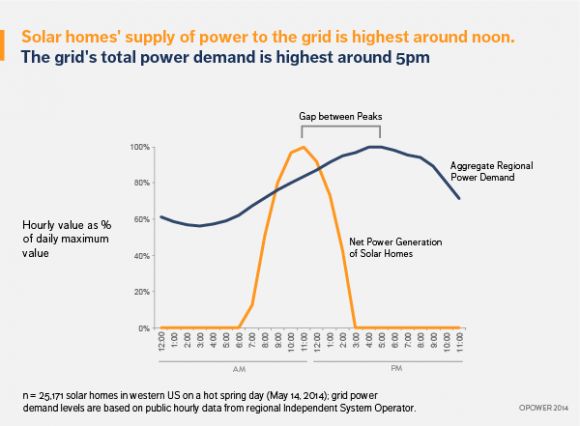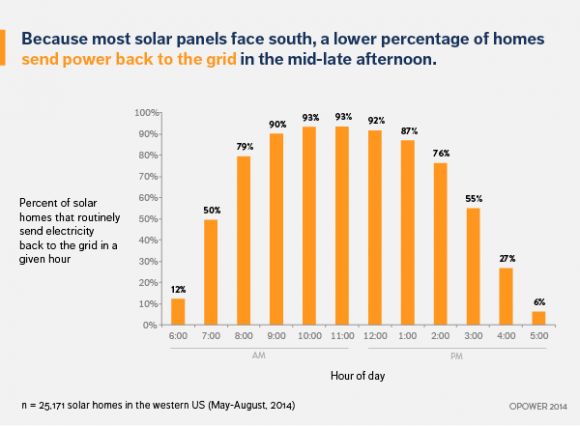The sun is shining on more solar panels than ever before. In the U.S., a new solar project is installed every 3.2 minutes, and the number of cumulative installations stands at more than 500,000.
Pull out your compass, and you’ll observe that most of these solar installations point southward. There’s a good reason why: south-facing panels capture the most sunlight and produce the most energy over the course of a year.
But as of late, many energy thinkers are pivoting toward the western sky. They’ve pointed out that west-facing solar panels are better at generating power in the late afternoon when the grid can benefit the most from the extra juice. A field study last year of 50 solar homes in Texas verified this west-facing advantage, and some sunny states are already betting on it. In September, the California Energy Commission lit the way when it announced a $500 incentive for the installation of west-facing panels on new homes.
So, how many rooftop solar systems currently point west? How many don’t? What’s at stake for utilities and consumers? And what are the implications for designing the power grid of tomorrow?
To shed some sunlight on these questions, we cracked open Opower’s energy data storehouse (the world’s largest, spanning more than 50 million households worldwide). We analyzed hourly electricity data from 25,000 solar homes in the western U.S., alongside public data from about 110,000 residential solar projects installed in California since 2007.
Our statistical results reveal a key disconnect between today’s solar panel landscape and the broader power system. But our findings also point toward a solution -- one that could make the 21st-century electric grid work better both for solar customers and their utilities.
Solar homes are mini power plants, but most of them are out of step with the grid
Throughout the sunniest hours of the day, a huge majority of solar homes produce more power than they consume. And in more than 40 states, their utility provider pays them for the excess power.
On an average day, 93 percent of the solar homes in our dataset export electricity to the grid.
That’s why a solar home’s consumption of grid electricity effectively goes negative for several hours in the middle of the day.

(Wondering why solar homes’ use of grid electricity shoots way above average after the sun goes down? It’s likely related to the elevated energy needs of their owners’ lifestyles: the typical solar home in our dataset is 34 percent larger than the typical non-solar home, 2.6 times as likely to own a pool and 2.7 times as likely to enroll in an electric vehicle rate plan.)
Solar homes tend to send the most power back to the grid around noon (corresponding with the bottom of the orange “U”). The size of their contribution is nothing to sneeze at. Between 11 a.m. and 1 p.m. on a typical day, a solar home produces enough electricity to fuel both itself and an entire non-solar home during those hours.
And on the hot springtime day depicted above (May 14, 2014), the average solar home produced enough power from 11 a.m. to 1 p.m. to fuel both itself and two non-solar homes. Impressive.
But here’s something less impressive: The typical solar home is severely misaligned with the needs of the electric grid.
To see why, check out the graph below. There’s a stark gap between when solar homes send the most extra power to the grid (around 12 p.m.) and when the grid most needs extra power (around 5 p.m.).

The solar and grid data presented above are from May 14 of this year -- a sun-soaked day that unleashed hot weather across the Western region. Grid electric demand (navy blue curve) peaked during the 5 p.m. hour, but was already extremely high by 3 p.m. Why does power demand reach a system-wide peak during the late afternoon hours? Think about it this way: many businesses are still in action, and many consumers are returning home from work and school to rev up their own appliances.
Accordingly, the late-afternoon power system could vastly benefit from importing extra electricity from solar rooftops as a compelling alternative to utilities firing up additional power plants.
But alas, most solar rooftops point south, as we detail further below. And that means they’ve sent their peak contribution of power to the grid much earlier in the day -- when south-facing panels receive their largest dosage of sunlight.
By the 4 p.m. hour, most solar homes generate enough power to reduce their own grid electric usage, but not enough to export power back to a grid that desperately needs it. The chart below shows that the number of solar homes spinning their meter backward drops off rapidly during the late-afternoon hours, just as regional power demand is reaching its pinnacle.

Could solar homes be more helpful in satisfying peak electric demand on the grid? The answer is certainly yes. And a small subset of homes appears to be leading the way.
About 9 percent of residential solar systems face the western sky
West-facing solar panels are better at producing power in the late afternoon, as the sun sinks and ultimately sets in the western sky. That aligns well with an electric grid that calls for extra power during that time -- especially in the hot months.
Whereas south-facing panels generate the most power around 12 p.m., west-facing panels hit their peak output around 2 p.m. They continue to out-produce their south-facing counterparts until the sun goes down. A recent analysis by researchers at the University of Texas quantified this pattern: they found that west-facing panels generate 23 percent more electricity than south-facing panels between 2 p.m. and 8 p.m. during the summer.
Facing west, however, has a fundamental drawback. It means missing out on sunlight that beams down from the non-western sky earlier in the day. As a result, west-facing panels generally produce 10 percent to 20 percent less total electricity than south-facing panels over the course of a year. Most solar homes today aren’t, for obvious reasons, willing to make that west-facing sacrifice.
And that’s why the vast majority of solar panels point south -- it’s the way to maximize year-round solar power production. Our data analysis of 110,000 residential solar systems in California verifies that south-facing systems clearly dominate the scene.

Overall, 71 percent of residential systems in the Golden State primarily face the southern sky, while 20 percent primarily face the western sky. Only around 9 percent of systems face within 10 degrees of due west -- an orientation that’s highly aligned with the needs of the grid, according to recent guidelines from the California Energy Commission.
Here’s a different visualization of the same data.

The 9 percent of California solar homes with fully west-facing systems -- and their enhanced capability to pump out power during the late afternoon -- represent a boon to utilities and other entities that manage the grid. But that may still leave you wondering: if west-facing panels produce a full 10 percent to 20 percent less electricity overall than south-facing panels, why would a customer ever choose west instead of south?
One reason could be that some people are simply stuck with a west-facing roof, but really want to put solar panels on it anyway, in spite of the reduced power production and weaker economic justification for the system. That may well explain the smattering of west-facing panels in the above chart.
But in tomorrow’s energy landscape, installing west-facing panels could be a much clearer choice.
Will west-facing panels go viral?
It depends.
A customer’s inclination to install a west-facing system will hinge on incentives. If their utility generously rewards homes that send power back to the grid in the late afternoon, a customer choosing between south-facing and west-facing panels may well opt for the western sky.
In fact, some utilities already offer such time-varying rate plans, in which customers exporting electricity in the late summer afternoon receive significant compensation (e.g., $0.35 per kilowatt-hour) relative to electricity exported around noon (e.g., $0.12 per kWh). Offering a handsome incentive for well-timed solar power (or well-timed reductions in usage) can be a smart play for any utility seeking to avoid a painful alternative: paying notoriously high marginal costs to source electricity from “peaker” power plants (typically 3 times to 5 times the normal price level).

In the regional dataset we analyzed, 4.6 percent of solar homes are currently enrolled in time-varying rates (compared to 1.3 percent of non-solar homes). Such rates could help (and may have already helped) nudge utility customers who own west-facing roofs to install a west-facing system. An appropriate time-of-use rate framework could enable west-facing systems to achieve compelling monetary returns despite their reduced annual energy output. Our recent analysis of time-varying rates -- specifically those that encourage nighttime electric car charging -- suggests they can have a strong effect in shaping consumer behavior.
Incentives to face west could also be offered upfront. One example is the California Energy Commission’s recent decision to award a subsidy of up to $500 for the installation of west-facing panels on new homes. In the same vein, Arizona’s largest utility recently proposed a $30 monthly lump payment to customers willing to host a west-facing system.
Utilities have already begun to leverage customers -- solar and non-solar -- as a reliable asset in managing peak electric demand. This past summer, more than 1 million customers across the country participated in "behavioral demand response" programs, wherein small changes in household behavior added up to large-scale regional peak reductions as high as 5 percent. One can imagine a similar development in the solar arena: a region with 25,000 solar rooftops, especially if strategically oriented, could send as much late-afternoon power back to the grid as a 50-megawatt natural-gas peaker plant.
In the future, technological advances may point the way toward different approaches to solar panel orientation. For example, solar trackers can swivel a solar panel from east to west over the course of a day to capture maximum sunlight. Today they are used in some large-scale systems. An affordable solar tracking technology for residential rooftops could render moot the entire question of “south vs. west.”
In a similar vein, the advent of effective energy storage technology may favor south-facing systems that maximize total electricity production, store it, and then use or export power during hours of peak regional demand.
These technologies are exciting, but today they are still expensive and experimental, and there’s no guarantee that they’ll be available at scale for the residential sector anytime soon.
In the meantime, the western sky is there for the taking.
***
Barry Fischer is the head writer at Opower, where he manages the Opower Outlier blog. Ben Harack is an implementation engineer at Opower.
This piece was originally published at Opower's Outlier blog and was reprinted with permission. For more details on how the research was conducted, see footnotes at the end of the piece. Follow @OpowerOutlier on Twitter.



